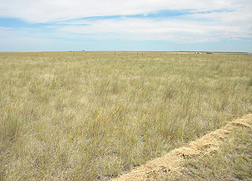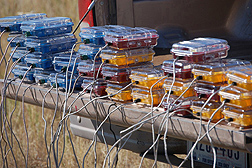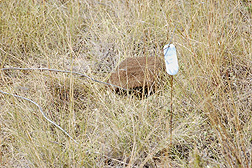Fighting a Pernicious Weed with Fire
Carefully staged “prescribed fire”can reset a rangeland’s biological clock, awaken dormant plants, and breathe new life and diversity into an ecosystem. When fire rolls over a rangeland, it gives perennial sod-forming grasses, which are good sources of forage for livestock, a better chance to take hold.
An Agricultural Research Service team in Miles City, Montana, is looking for ways to use fire to control a weed on the Northern Plains and on western range-lands. The weed is purple threeawn, and it is colonizing disturbed soils and overtaking rangelands used for grazing. When fully grown, the plant has sharp prongs that make it undesirable to cattle, and the cattle do not thrive if it becomes a staple of their diet.
The researchers—range ecologist Lance Vermeire, range technician Dustin Strong, and their colleagues—are in the ARS Range and Livestock Research Unit in Miles City.
Fire is commonly used on rangelands in the Southern Plains (Oklahoma, Texas, and Kansas), but it was not as readily adopted by settlers west and north of those areas. Because of that, less is known about its effectiveness as a management tool in the areas where purple threeawn is becoming more of a problem. The research is largely funded by the U.S. Bureau of Land Management, which manages much of the rangeland in the United States.
Effects of Fire
To find out whether fire is useful in controlling threeawn, Vermeire, Strong, and their partners are probing a number of issues, including which season is best for using fire. The researchers want to determine whether fire not only reduces the abundance of purple threeawn, but also creates more balanced ecosystems where desirable grasses can flourish. Their intent is to give land managers a way to keep rangelands viable so that cattle grazing on them can stay healthy and well fed.
“We don’t just want to discourage the bad weeds; we also want to promote the good grasses, such as western wheatgrass, needleandthread, and other native perennial grasses,” Vermeire says.
The researchers grew purple threeawn and two desirable grasses—western wheatgrass and blue grama—in a greenhouse to study the effects of fire under controlled conditions. Some purple threeawn was grown in isolation, and some was intermixed with the two grasses. They applied fire to some plants and let others grow unimpeded, and they clipped both the burned and control plants to specific heights to simulate cattle grazing. Combusted materials, clipped material, and final biomass of all plants were measured to assess plant production levels.
Results showed that fire killed 36 percent of the purple threeawn and reduced its biomass by 61 percent, reductions the researchers say were significant. Though this study was done in a greenhouse, the researchers say the results indicate that fire treatments would likely have significant impacts for reducing purple threeawn on open rangelands. The study was published in Rangeland Ecology and Management in 2013.
|
|
The Right Timing
Another key question is when to use fire. Most prescribed fires are set in rangelands during spring or fall, but a plant’s response to fire varies with its stage of development and activity level. Most native grasses in Montana are cool-season plants that have adapted to the natural cycle of frequent summer wildfires. They go dormant in the summer, making them less susceptible to summer fires. Purple threeawn, however, is a warm-season species that grows during the summer, which should make it more susceptible to summer fires.
In a study at two Montana field sites, plots were either burned during the summer or fall or were not burned at all, and each of those treatments had either no nitrogen or one of two levels of nitrogen added. Precipitation levels varied widely: Spring 2011 saw record rainfall, but spring 2012 was one of the driest on record.
The results showed that while fall fires reduced purple threeawn production, summer fires were much more effective, particularly after a wet spring. “Few rangeland treatments have shown such immediate effects with just a one-time application,” Vermeire says. In comparison to the control plots, the weed’s overall biomass was reduced 90 percent by the summer fire and 73 percent by the fall fire after the wet spring. By comparison, it was reduced 73 percent by the summer fire and 58 percent by the fall fire after the dry spring. Adding nitrogen to the soil had no effect on purple threeawn production at any of the sites nor on growth of the more desirable perennial grasses after the dry spring, but it doubled grass production after the wet spring.
The study was published in Rangeland Ecology and Management in 2013.
Heat Dosage and Duration
When conducting prescribed burns, land managers can control certain factors such as the temperature, duration, and the amount of heat applied. The duration of a fire, for instance, can be prolonged by allowing plant litter to accumulate or by burning in light winds or when the plant material is moist. “Dosage” could be defined by how hot and how long a fire burns, the researchers say.
In another study at the Montana sites, the researchers placed data loggers at the base of purple threeawn plants to record the temperatures during prescribed fires. The purpose was to assess the effects of temperature, heat duration, and heat dosage. The loggers recorded temperatures every second the fires burned.
The results, published in 2013 in Fire Ecology, showed that heat dosage and duration are more important than maximum temperature. The scientists conclude that summer fires, with their higher dosage and duration levels, provided more benefit than fall fires.
Vermeire said the results could also be attributed to purple threeawn’s growth cycle. “Because purple threeawn grows and reproduces during the summer, setting it on fire in summer rather than fall is more likely to shut down that process,” he says.—By Dennis O'Brien, Agricultural Research Service Information Staff.
The research is part of Pasture, Forage, and Rangeland Systems (#215), an ARS national program described at www.nps.ars.usda.gov.
Lance Vermeire and Dustin Strong are with the USDA-ARS Livestock and Range Research Laboratory, 243 Fort Keogh Rd., Miles City, MT 59301-4016; (406) 874-8206 [Vermeire], (406) 874-8280 [Strong].
"Fighting a Pernicious Weed with Fire" was published in the April 2014 issue of Agricultural Research magazine.









